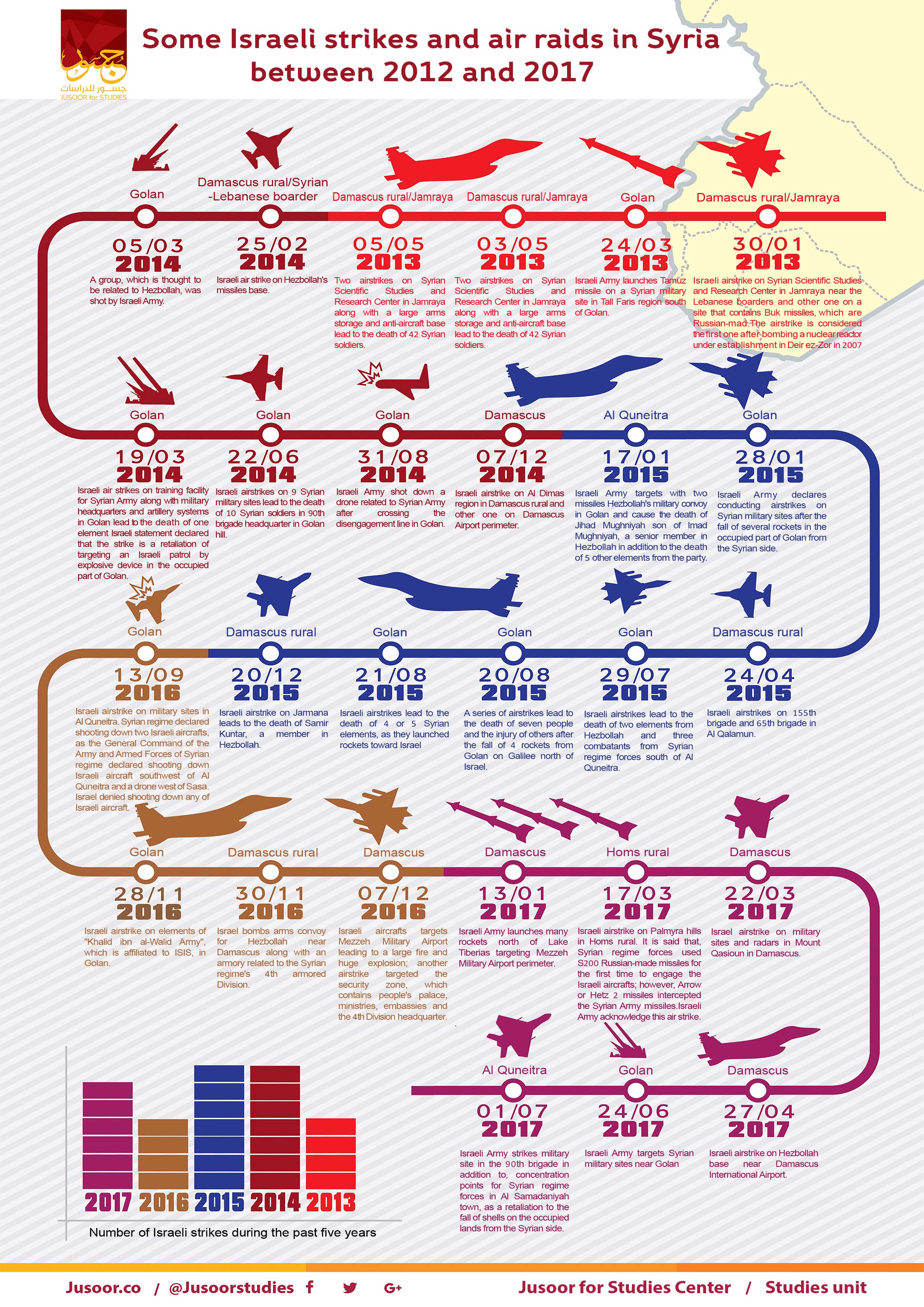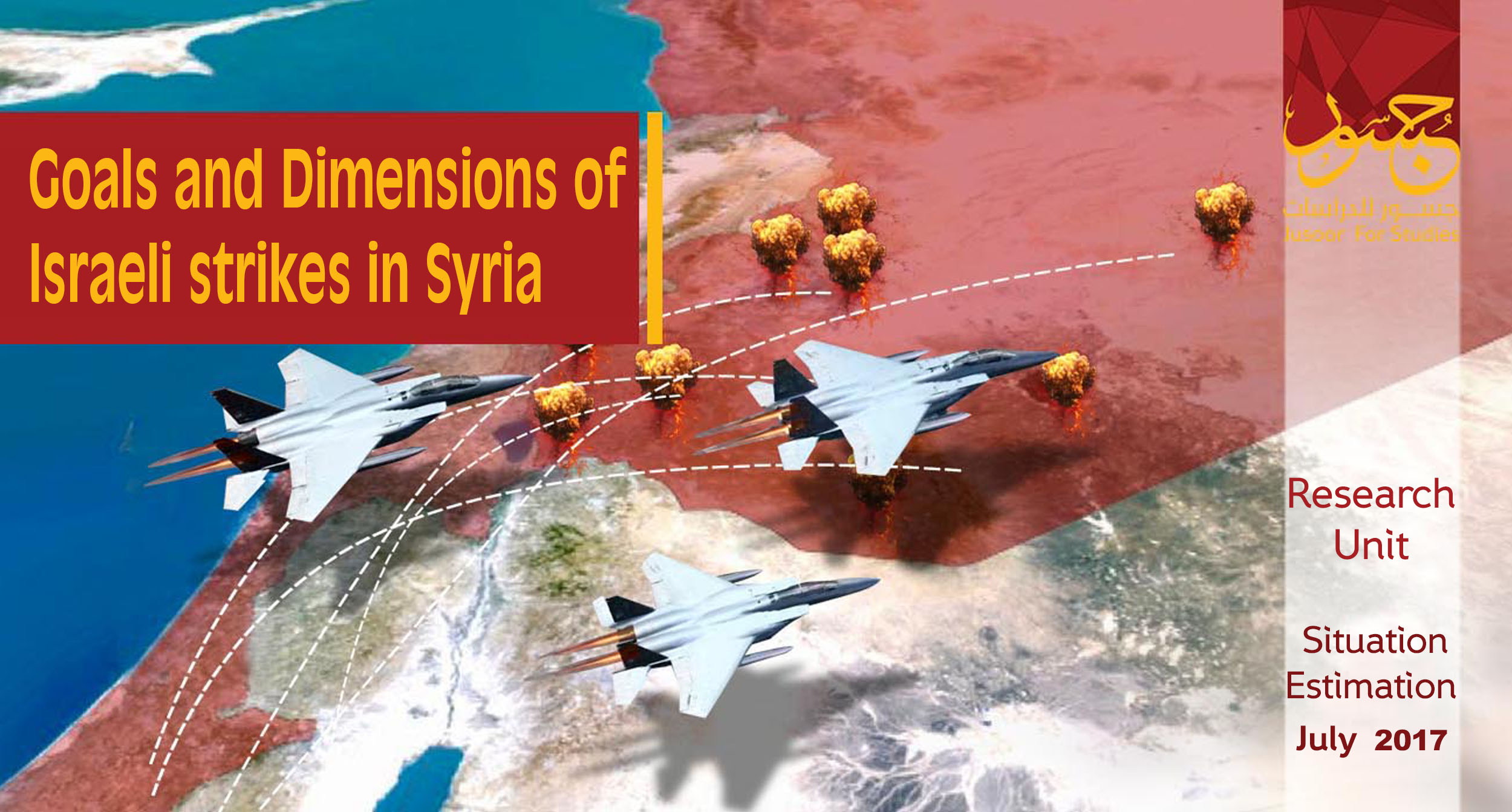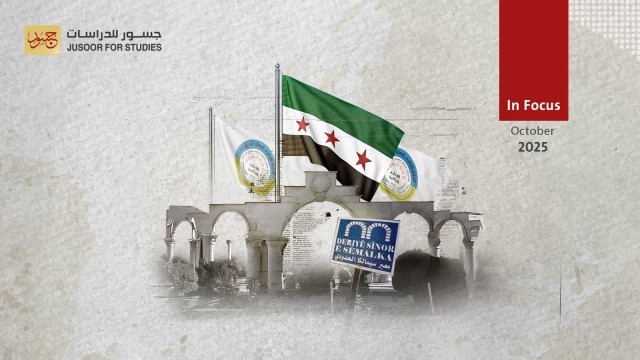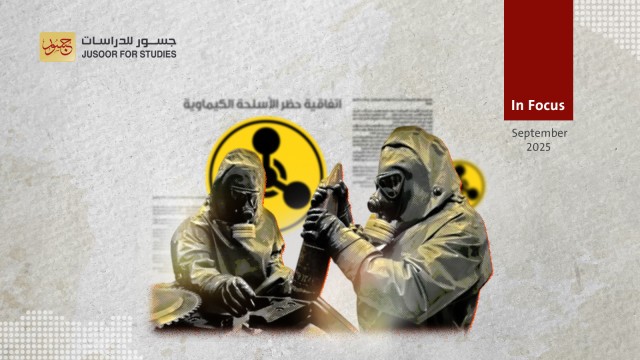Goals and Dimensions of Israeli strikes in Syria
Font Size
Preface
Israeli position toward the Syrian affair is the most complicated regional positions, as Israel is still neutral vis-à-vis this crisis even though no conflicts were recorded between the Syrian opposition and Israel in the Syrian half of Golan, limiting on few airstrikes against ISIS-affiliated groups. There is a general impression in the political circles that Israel is one of the international powers, which works against Al-Assad regime downfall.
The complexity of the Israeli position is related to: its complicated international and regional location – Tel Aviv has different interests from the rest countries of the region or even from Europe and U.S.
Since 2013, Israel has conducted dozens of air strikes in Syria after six years of suspending them. Neither Syrian regime nor Israel issued any statements about the nature of the targeted sites.
In this report, we will try to understand the nature of these airstrikes and missile attacks from 2013 till now in addition to analyze the way of addressing these strikes by relevant actors especially Russia and Syrian regime, knowing that such airstrikes target the structure of regime's political discourse, which is based on two ideologies: resisting Israel and defending Syria's sovereignty!
Israel air strikes in Syria
Since 1967, Israel has continued to target Syrian regime forces on regular basis. In 2006, Israeli aircrafts broke the sound barrier in Lattakia and flew over the presidential palace during the presence of Bashar Al-Assad.
In 2008, Israeli aircrafts bombed a military site in Deir ez-Zor Governorate, describing it as a nuclear reactor under establishment. According to majority of estimations, General Muhammad Suleiman was assassinated by Israel during his presence in a beach resort near Tartus.
During all these attacks, Syrian regime showed no capability in facing Israeli violations, following the policy of "restraint" and threatening of retaliation in "the appropriate time and place"!
The frequency of Israeli attacks has increased since 2013 with no coverage from Syrian regime media or its allies' media except some of them, as strikes took place in Damascus and was hard to be ignored like the one that targeted the 4th armored division in Mount Qasioun.
There is no accurate number of the Israeli strikes in Syria because Tel Aviv is abstaining from issuing any statements about them except some specific situations. Syrian regime is also refraining from the declaration of any of these strikes unless it was obliged to do so, such as: targeting sites near the residential areas – targeting notable characters from Hezbollah.
On 19/7/2017, Israeli prime minister declared that: “Israel has conducted dozens of airstrikes in Syria during the past five years”.
Table 1 presents an illustration of the recorded Israeli air strikes through the past five years.
It is notable in the table that 36% of air raids focused on Golan due to the tactical character of the rules of engagement on the borders between Golan's two halves.



Strategic Motivations
Through displaying the Israeli strikes followed by limited Israeli statements, three strategic objectives to be inferred, as all of them are related to safeguarding its sheer interests away from the scales of Syrian war or supporting one side rather than the other. These objectives are:
1. Chemical Arsenals
Israel seeks expediency of Syrian regime to destroy the chemical arsenals along with preventing any transition of their technologies or components to other actors like Hezbollah, ISIS or Syrian opposition.
Jamraya site, which includes Syrian Scientific Studies and Research Center specialized in biological and chemical arms, witnessed the first Israeli attack since the destruction of nuclear reactor under establishment in Deir ez-Zor in 2007.
2. Arsenals of Missiles
Destruction of Syrian Army's long-range missiles along with anti-aircraft defense systems, is considered a very important objective for Israel because this arsenal will be a second military threat for Israel in case of being used by Al-Assad regime, opposition forces or any active force in the nearby region.
Since 2013, Most of the Israeli air strikes have focused on this arsenal especially Russian-made Scud missiles in Syria, as Israel exploited the chance of the Syrian regime forces lack of readiness for any war, at which, they were very weak to face the Israeli Army even without being engaged in any war nationwide. However, when Israel targeted regime's forces in Homs rural on 17th March 2017, the Syrian regime felt the necessity of retaliation, which took place as a moral response, by any means necessary because this strike exceeded the norms in some way.
3. The Terrorist Organizations and Militias
Israel seeks removing the "terrorist" organizations' threat including Iranian-backed militias, as targeting or even damaging the Jewish State may represent this danger. The thing that explains targeting long-range weapons before or during moving them to Lebanon in addition to conducting strikes against groups and joint cells including Iranian Revolutionary Guards' officers.
Benjamin Netanyahu considered the above-mentioned is the main objective of all Israeli strikes in Syria .
It's notable that, Israel wasn't worried of Hezbollah participation in Syria despite the presence of the party substantial camps in Damascus rural along with using advanced arms against Syrian opposition. Israel was only targeting the transfer of advanced weapons to Lebanon.
Israeli aircrafts targeted ISIS-affiliated "Khalid ibn al-Walid Army" with one air strike after an exchange of fire in Golan boarders area, at which elements from "Khalid ibn al-Walid Army" opened fire on Israeli soldiers during a security activity by the last party in the buffer strip.
The Time of Israel website illustrated in a previous analysis concerning ISIS presence near occupied Golan borders that, Israelis have nothing to fear from ISIS"
Tactical objectives
After showing the strategic objectives behind the military strikes against Syrian regime, there is still one more objective as a tactical one related to the rules of engagement on Golan borders, at which Israeli Army's units continued to retaliate any violations of these rules or any close mobilizing from the Syrian side through shelling the regime forces randomly in Al-Quneitra Governorate.
These attacks were frequent and declared officially by Tel Aviv, contrary to the ones in other Syrian parts, as Israel used to be discreet, however, giving hints every now and then of being responsible for these attacks took place. On 1/12/2015, Israeli prime minister acknowledged executing military strikes against Hezbollah arms convoys without adopting any specific attacks . In some exceptional cases, Israel had to declare the attack which was encountered by Syrian regime forces for the first time through launching anti-aircraft missiles that tracked the Israeli aircrafts till the Jordanian boarders, as Israeli defenses destroyed them and their debris fragments fell in Jordan, on 17/3/2017.

Israeli – Russian Coordination
Israeli airstrikes in Syria started in 2013 and continued with close rate, however, the Russian intervention forced Israel to follow new methods which are considered as restrictions due to the necessity of coordination between the two countries especially in the duration of Obama presidency. Tel Aviv regarded US as a rival that time.
Strikes Restrictions
Both parties declared an agreed coordination concerning the prevention of any undesired military flight incidents in Syria after one month of the Russian intervention. The agreement was affirmed by Moshe "Bogie" Ya'alon, Israel's Defense Minister, as he said that: “the two countries are coordinating the security procedures to avoid any incidents and there is no kind of interfering in the business of both countries by this process ” which means that, first restriction on Israel took place because Russia should be informed about any Israeli future strike in Syria before a sufficient duration.
Another restriction on Israel is: no sites in Syria to be targeted by Tel Aviv except the ones related to Hezbollah. Israeli prime minister acknowledged this commitment from his country after a meeting with Russian president a few weeks later to the Russian intervention.
After the Russian intervention, frequency of Israeli strikes slowed down contrary to what was expected. Israeli moves were relatively shrunk despite the declaration of coordination between Israel and Russia concerning air raids in Syria, as during the first year of Russian intervention, Syria witnessed one air raid in Dec 2015 which led to the death of Samir Kuntar.
Despite the disclosure from the two parties concerning what comes beyond this coordination, Netanyahu and Ya'alon declarations indicate to a kind of unannounced restrictions on the Israeli strikes such as: Israeli commitments not to attack Al Assad forces, advanced weapons storage, long range missiles or defensive systems, however, Israel can target Iran-affiliated militias, which indicates a previous accordance between Israel and Russia to limit and decrease the Iranian influence in Syria. Russia showed a desire of expanding its influence in Syria like the scenario which took place in Aleppo after displacing locals of the eastern neighborhoods.
Why did Russia condemn the last two Israeli air strikes?
Despite the fact that Russia condemned the last Israeli strike before a year of the Russian intervention, the condemnation of the last two airstrikes on weapons storages near Damascus International Airport had a particular resonance, as Israeli Journals stated that: “Hezbollah site were targeted there”. Moreover, according to Israel claims, the previous Israeli airstrike, which took place near Palmyra, was against Hezbollah’s weapons storages, to which Russian Foreign Ministry summoned the Israeli ambassador in order to contest the strike in Palmyra, as Maria Vladimirovna Zakharova, Director of the Information and Press Department of the Ministry of Foreign Affairs of the Russian Federation, described the last Israeli strike near Damascus airport as a hostile act, calling on all countries to respect “Syria Sovereignty ”.
The explicit Russian condemnation toward the last two airstrikes can’t be comprehended without taking into consideration two possibilities:
First Possibility: these two airstrikes violated the Russian-Israeli agreement, which indicates that, the Israeli unofficial narrative about its strike near Damascus airport along with the other official one about its strike near Palmyra weren’t true from the Russian perspective which means that, Tel Aviv targeted advanced missiles storages especially Russian-made Scud missiles that the Syrian forces control away of the Iranian militias hands. This possibility seems more likely because destroying Al Assad forces’ long-range missiles is a strategic objective for Tel Aviv. These kinds of strikes were temporarily abandoned by Israel for the sake of coordinating with Russia along with the uncertainty of the American protection in case any conflict takes place. The arrival of a new and stricter American administration, gave Tel Aviv the choice to restore some of the missing margins under the cover of targeting Iranian militias.
Second Possibility: Israeli narrative was true, but Russia was in a difficult position toward its allies especially Iran, at which Russia already failed to protect Al Assad forces in Shayrat Military Airbase near Homs in conjunction with a Russian frustration from any hoped Israeli role to close the Kremlin from Trump, which is another valid possibility.
The common thing between the two possibilities is that: there is a sudden contention in Russian-Israeli ties after the American strikes on Shayrat Military Airbase, which caused a rapid exacerbation in former disagreements. The new American administration lacks any convergence with Moscow accompanied by a rise in American hostile tone toward Russia, contrary to what was expected.
Margins:
1-Netanyahu accidentally reveals Israel has struck Iran-backed fighters in Syria ‘dozens of times’, The Washington Post, 19/7/2017
2-Netanyahu accidentally reveals Israel has struck Iran-backed fighters in Syria ‘dozens of times’, The Washington Post, 19/7/2017
3-Israel isn't afraid of ISIS, The Times of Israel, 8/9/2016
4-For the first time, Netanyahu acknowledges officially of conducting strikes in Syria, Russia Today, 1/12/2015
5-Israel: there is no coordination with Russia concerning Syria, Russia Today, 28/10/2015
6-Kremlin calls on respecting Syria sovereignty against the backdrop of Israeli strikes, Russia Today website, 28/4/2017
2-Netanyahu accidentally reveals Israel has struck Iran-backed fighters in Syria ‘dozens of times’, The Washington Post, 19/7/2017
3-Israel isn't afraid of ISIS, The Times of Israel, 8/9/2016
4-For the first time, Netanyahu acknowledges officially of conducting strikes in Syria, Russia Today, 1/12/2015
5-Israel: there is no coordination with Russia concerning Syria, Russia Today, 28/10/2015
6-Kremlin calls on respecting Syria sovereignty against the backdrop of Israeli strikes, Russia Today website, 28/4/2017








